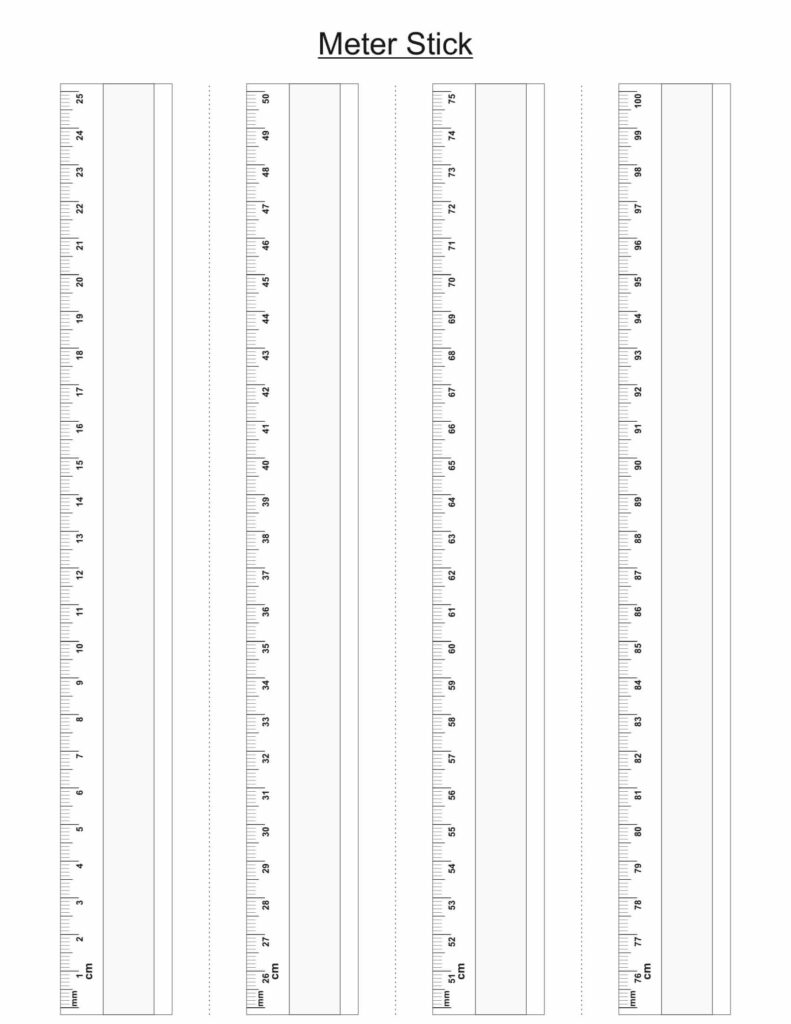A meter stick is one of the most valuable tools in the classroom. It can be used to measure length, width, height, and even angles.
Table of Contents
What is a Meter stick Ruler?

A meter stick is a ruler that is one meter long. It can measure length, width, height, and even angles. A meter stick is a handy tool in the classroom. It can be used to measure length, width, height, and even angles.
As a meter stick is one meter long, but in the printable version, you get it in pieces that can fit together to make a meter.
See also:
- Printable 6 Inch Ruler Actual Size
- Printable 12 Inch Ruler Actual Size
- Centimeter Ruler Printable
- Printable Ruler Actual Size
- Printable Square Ruler Template
- Printable Yardstick Template
What are the Key uses of Meter Stick?
- Measure the length of an object.
- To find the width of an object.
- For Height measurement.
- For measuring angles.
How to Print and Connect Meter Stick?
You can print the meter stick ruler on a sheet of paper or cardstock. You will need to connect the pieces to make a meter stick. You can use tape or glue to attach the pieces.
You are ready to use when you have printed and connected the meter stick! Use it to measure length, width, height, and even angles.
How to Read a Meter Stick?
Marks on a meter stick are usually spaced 1 centimeter apart. The numbers on the meter stick represent the centimeters (cm) or millimeters (mm). There are 100 centimeters in one meter.
- To measure the length of an object, line up the object with the zero mark on the meter stick. The numbers that align with the other end of the object represent the measurement. For example, if you are measuring a pencil, and the 5 centimeter mark lines up with the other end of the pencil, the length of the pencil is 5 centimeters.
- To find the width of an object, line up one side of the object with the zero mark on the meter stick. The numbers that align with the other side of the object represent the width. For example, if you are measuring a piece of paper, and the 10-centimeter mark lines up with the other side of the paper, the width of the paper is 10 centimeters.
- To measure the height of an object, line up the object with the zero mark on the meter stick. The numbers that align with the top of the object represent the height. For example, if you are measuring a book, and the 30-centimeter mark lines up with the top of the book, the height of the book is 30 centimeters.
- To measure angles, line up one side of the angle with the zero mark on the meter stick. The numbers that align with the other side of the angle represent the measurement. For example, if you are measuring an angle, and the 45-degree mark lines up with the other side of the angle, the measurement of the angle is 45 degrees.
A meter stick is a handy tool in the classroom. It can be used to measure length, width, height, and even angles. Meter sticks are usually marked in centimeters, so they can be used to measure metric units. Be sure to line up the object you measure with the zero mark on the meter stick to get an accurate measurement.
Conclusion
This post has everything that you need to make about meter sticks! If you want to know more about the different types of meter sticks and how it can be used, this post is for you. We hope that you found this post helpful and has given you a better understanding of these tools.

Col Mitchell is on a mission to help students and others become independent. She believes everyone should have access to the resources they need to succeed, regardless of their background. That’s why she created innovative tools such as protractors and lined paper. Her vision is to make learning easier, faster, and more enjoyable for all users. With Col Mitchell’s tools, people of all ages can enjoy an improved educational experience.
